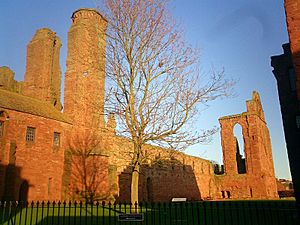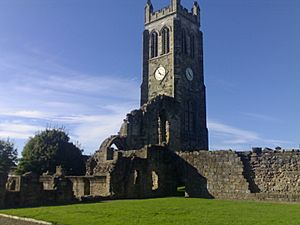Bernard of Kilwinning facts for kids
Quick facts for kids Bernard |
|
|---|---|
| Bishop of the Isles | |
| Church | Catholic Church |
| See | Diocese of the Isles |
| In Office | 1327 x 1328–1331 |
| Predecessor | Gillebrìghde MacGilleFhaolain |
| Successor | Thomas de Rossy |
| Orders | |
| Consecration | 26 June x 12 November 1328 |
| Personal details | |
| Born | unknown uncertain |
| Died | c. 1331 Buried in Kilwinning Abbey |
| Previous post | Abbot of Kilwinning (x 1296–1296 x 1305) Chancellor of Scotland (1306 x 1308–1328) Abbot of Arbroath (1310–1328) |
Bernard was an important church leader and government official in Scotland. He lived in the late 1200s and early 1300s. This was a time when Scotland was fighting for its independence from England.
Bernard started as an abbot, which is the head of a monastery. He was first the Abbot of Kilwinning. Later, he became a very important government official called the Chancellor of Scotland. He also served as the Abbot of Arbroath.
Many people believe Bernard helped write the famous Declaration of Arbroath. This was a letter sent to the Pope asking him to recognize Scotland's independence. Bernard later became a bishop in the Diocese of the Isles. He died around the year 1331.
Contents
Bernard's Early Life as an Abbot
Bernard first appears in historical records as the Abbot of Kilwinning. This was in 1296. His name is on a list called the Ragman Rolls. This list included Scottish nobles and clergy who swore loyalty to the English king.
After 1296, Bernard's name is not seen for a while. It's possible he was removed from Kilwinning Abbey by the English king. He might have moved to another monastery called Arbroath Abbey. By 1305, someone else was named Abbot of Kilwinning.
For a long time, historians thought this Bernard was a different person. But now, it's clear that the Abbot of Kilwinning was the same Bernard. He later became the Chancellor of Scotland, Abbot of Arbroath, and Bishop of the Isles.
Chancellor of Scotland and Abbot of Arbroath
Around 1308, Bernard started working for King Robert I of Scotland. He became the "Chancellor of Scotland." This was a very high-ranking job in the king's government. The chancellor was like a chief secretary or head of administration.
At this time, King Robert gained control of the area where Arbroath Abbey was located. The abbot there was removed, and Bernard was chosen as the new Abbot of Arbroath in 1310.
As abbot, Bernard traveled to Norway. He went there to make a peace agreement with the Norwegian king. He returned in 1312. Later that year, Norwegian ambassadors met King Robert in Scotland. They agreed to the Treaty of Inverness. This treaty renewed an older agreement and settled some arguments between Scotland and Norway.
Bernard is often given credit for writing the Declaration of Arbroath. This important document was written during his time as Abbot of Arbroath. It was a letter sent to the Pope in 1320. The letter asked the Pope to recognize Scotland as an independent kingdom. It also stated that the Scottish people would never be ruled by England.
While Bernard's name was on the Declaration, some historians are not sure if he wrote every word. However, as Chancellor, he definitely played a big part in its creation. He held the job of Chancellor throughout his time as Abbot of Arbroath. This meant he was very involved in the king's government. He helped create many official documents and laws.
Becoming Bishop of the Isles
Bernard had served King Robert I for many years. As a reward, he was made a bishop in the winter of 1327 or 1328. He became the Bishop of the Isles. This was a special position that the king had reserved for someone he trusted.
Bernard gave up his role as Chancellor in 1328. King Robert helped Bernard with the costs of becoming a bishop. He also gave him some income from church lands. This was important because the Diocese of the Isles did not have a lot of money.
Bernard became a bishop between June and November 1328. He might have been consecrated in Norway. This is because the main church leader for the Diocese of the Isles, the Archbishop of Trondheim, lived there.
Bernard's election as bishop was not completely smooth. Some church officials in the Isles had chosen a different person. But Bernard's election was eventually confirmed.
Bernard did not serve as bishop for very long. He died by June 1331. Historical records suggest he was bishop for about three or four years. The Chronicles of Mann (a historical record from the Isle of Man) says he was buried at Kilwinning Abbey. This was the monastery where he first started his church career.
Images for kids





